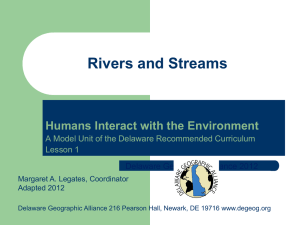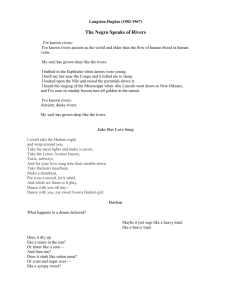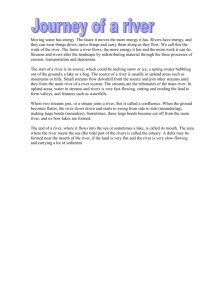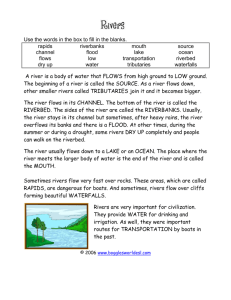Wild Rivers in Australia
advertisement
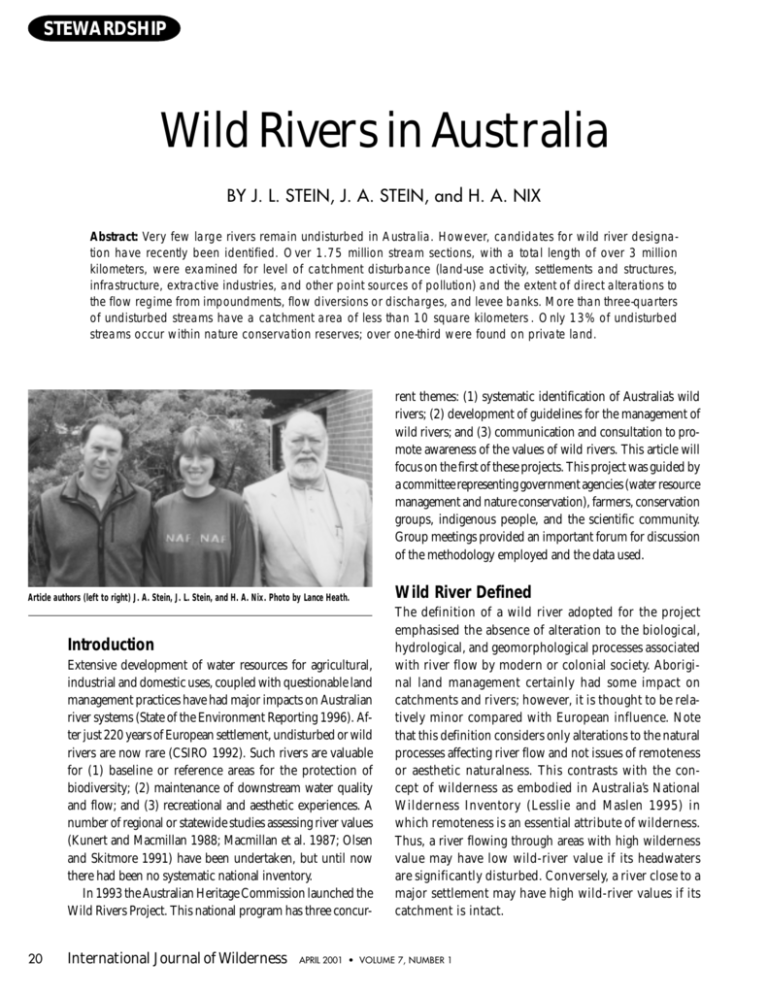
STEWARDSHIP Wild Rivers in Australia BY J. L. STEIN, J. A. STEIN, and H. A. NIX Abstract: Very few large rivers remain undisturbed in Australia. However, candidates for wild river designation have recently been identified. Over 1.75 million stream sections, with a total length of over 3 million kilometers, were examined for level of catchment disturbance (land-use activity, settlements and structures, infrastructure, extractive industries, and other point sources of pollution) and the extent of direct alterations to the flow regime from impoundments, flow diversions or discharges, and levee banks. More than three-quarters of undisturbed streams have a catchment area of less than 10 square kilometers . Only 13% of undisturbed streams occur within nature conservation reserves; over one-third were found on private land. rent themes: (1) systematic identification of Australia’s wild rivers; (2) development of guidelines for the management of wild rivers; and (3) communication and consultation to promote awareness of the values of wild rivers. This article will focus on the first of these projects. This project was guided by a committee representing government agencies (water resource management and nature conservation), farmers, conservation groups, indigenous people, and the scientific community. Group meetings provided an important forum for discussion of the methodology employed and the data used. Article authors (left to right) J. A. Stein, J. L. Stein, and H. A. Nix. Photo by Lance Heath. Introduction Extensive development of water resources for agricultural, industrial and domestic uses, coupled with questionable land management practices have had major impacts on Australian river systems (State of the Environment Reporting 1996). After just 220 years of European settlement, undisturbed or wild rivers are now rare (CSIRO 1992). Such rivers are valuable for (1) baseline or reference areas for the protection of biodiversity; (2) maintenance of downstream water quality and flow; and (3) recreational and aesthetic experiences. A number of regional or statewide studies assessing river values (Kunert and Macmillan 1988; Macmillan et al. 1987; Olsen and Skitmore 1991) have been undertaken, but until now there had been no systematic national inventory. In 1993 the Australian Heritage Commission launched the Wild Rivers Project. This national program has three concur- 20 International Journal of Wilderness Wild River Defined The definition of a wild river adopted for the project emphasised the absence of alteration to the biological, hydrological, and geomorphological processes associated with river flow by modern or colonial society. Aboriginal land management certainly had some impact on catchments and rivers; however, it is thought to be relatively minor compared with European influence. Note that this definition considers only alterations to the natural processes affecting river flow and not issues of remoteness or aesthetic naturalness. This contrasts with the concept of wilderness as embodied in Australia’s National Wilderness Inventory (Lesslie and Maslen 1995) in which remoteness is an essential attribute of wilderness. Thus, a river flowing through areas with high wilderness value may have low wild-river value if its headwaters are significantly disturbed. Conversely, a river close to a major settlement may have high wild-river values if its catchment is intact. APRIL 2001 • VOLUME 7, NUMBER 1 The Wild River Method Direct measures of river condition, while preferable, are lacking or piecemeal for many Australian rivers (BIOSIS 1993). They are usually only available for more degraded rivers and may be difficult to interpret due to the lack of baseline information from undisturbed systems. However, the intensity and extent of human activities within a catchment and, where available, data that indicate changes to the flow regime, provide surrogate measures of the extent to which natural river processes have been degraded. A GIS procedure, based on a drainage analysis of a 250meter resolution DEM (a regular grid of elevation) (Stein, Stein, and Nix 1998), was developed to rate the level of disturbance for stream sections. This procedure uses derived indicators based on four major sources of catchment disturbance with potential to significantly alter river processes: (1) land-use activity, (2) settlements and structures, (3) infrastructure, and (4) extractive industries and other point sources of pollution. These indicators are combined with another set of indicators based on alterations to the flow regime from in-stream disturbances: (1) impoundments, (2) flow diversions or discharges, and (3) levee banks. The composite River Disturbance Index (RDI) provides an overall rating. Wild rivers are then defined within the context of such ratings for all Australian rivers along a continuum from near pristine to highly degraded. The Results RDI was derived for over 1.75 million stream sections with a total length of over 3 million kilometers from the digital 1:250,000 scale map series (AUSLIG 1992). This index allowed rivers to be ranked from undisturbed (RDI = 0) to severely disturbed (RDI approaching 1). By setting an appropriate threshold, potential wild rivers can be identified. In this case, a threshold of 0.01 was chosen, in consultation with the Wild Rivers Project Advisory Committee. Stream sections with RDI values less than 0.01 are essentially undisturbed or, at most, have minimal disturbance in the catchment (for example, a minor trail some distance from the stream or a history of selective logging many decades ago in a small proportion of the catchment). Only 19%, or 591,332 kilometers, of the total stream length assessed satisfied this criterion. Not surprisingly, these undisturbed rivers are found within the less densely populated areas of Australia and outside intensive agricultural zones. More surprising, however, is the land tenure classification of these undisturbed rivers (see table 1). Only 13% of the undisturbed stream length falls within existing nature conservation reserves, and within these reserves nearly half of the stream length was disturbed to some extent. Although only 9% of the stream length Table 1—Length of undisturbed streams (RDI value less than or equal to 0.01) by tenure category. International Journal of Wilderness APRIL 2001 • VOLUME 7, NUMBER 1 21 Table 2—River Basins with greater than 80% of stream length undisturbed (RDI value less than or equal to 0.01). on private lands was undisturbed, this comprised 36% of the total length of undisturbed sections. Figure 1 summarizes the results by drainage basins (AUSLIG 1997), which provide the framework for the collation of national hydrological data and water resource planning. Only a few basins are largely undisturbed (see table 2). In many basins, only small headwater streams remain undisturbed. If individual rivers are considered, more than 13,000 were found to be essentially undisturbed for their entire length. However, 75% of these are small streams with a catchment area of less than 10 square kilometers. Only six rivers with a catchment area greater than 10,000 square kilometers were identified as potentially wild, and all of these are found in northern Australia. Analysis of the distribution of undisturbed streams in relation to environmental domains highlights the underrepresentation of potentially wild rivers in particular environments (see table 3). Only 14% of the total length of streams in the arid/semi-arid domain (covering more than 75% of the Australian land mass) were identified as undisturbed. These generally short, ephemeral streams make up 42% of the total length of undisturbed streams in the nation, however. Another 42% of the undisturbed streams were found in the monsoonal tropical north of Australia where streams are characterized by extremely high peak flows. In the southwest Tasmanian World Heritage Area (cool temperatures, high runoff), the majority of streams (74%) were found to be undisturbed but only contributed 1% to the national total. Discussion Figure 1—Australia’s river basins showing proportion of stream length that is undisturbed (RDI value less than or equal to 0.01). 22 International Journal of Wilderness APRIL 2001 • VOLUME 7, NUMBER 1 A preliminary list of wild rivers was produced from those river sections with an RDI value of less than or equal to 0.01. However, RDI values represent a continuum of disturbance. In addition, the actual level of degradation to natural stream processes may vary for the same value of RDI, depending on river type and the environmental characteristics of the catchment. Thus, streams with RDI values just above the chosen threshold may also be candidates for inclusion. A final list is being compiled in consultation with state agencies that have legislative responsibility for rivers (Environment Australia, forthcoming) after verification, which may include field checking and reference to local information. Additional criteria, such as minimum length or catchment size, may also be applied. For example, currently in New South Wales a wild river has a minimum continuous segment length of at least 10 kilometers; in Tasmania, wild rivers have a minimum catchment area of 1,000 hectares. A verification study was conducted for the rivers in the Kimberley region of western Australia (Williams and Penn 1995) where excessive grazing pressure is the major cause of riverine degradation. Aerial inspection and onground truthing was used to assign rivers to one of five major categories, ranging from wild to degraded, based principally on evidence of erosion and sediment deposition. Comparison of results found that the RDI values provided a reasonably similar indication of candidates for wild river designation but highlighted limitations in the supporting data related to grazing. For example, much of the catchment of the Drysdale River is within a national park and therefore assumed to be ungrazed. However, field inspection of this river, identified as potentially wild from its RDI ratings, showed some degradation due to grazing by feral cattle in the unfenced national park. Other limitations of this assessment relate both to the underlying assumptions in the river disturbance model and the supporting data used (Stein et al. 1998). For example, much information of relevance to river condition was simply unavailable. This included the condition of riparian vegetation, changes in fire frequency and intensity, the presence of exotic species, the intensity of catchment grazing by feral animals, and the location of river engineering works. Nevertheless, the approach developed has a number of advantages. It rates all streams in a consistent and transparent manner and offers considerable flexibility. The database can be readily updated and parameters easily modified. Assessment of the impact of pro- The Salmond River in the Kimberley region in western Australia is one example of the 1.75 million stream sections surveyed to develop a relative disturbance index (RDI). Photo by J. A. Stein. posed developments on wild-river values is also accommodated. For the first time, a national assessment of river disturbance was produced, providing a listing of potentially least-disturbed wild rivers. Only a few major rivers were found to be undisturbed for their entire length, but many important undisturbed smaller streams and headwa- ter tributaries were identified. Some of these may be the only undisturbed examples of particular river types. An assessment of the adequacy of the existing conservation reserve system would be an important sequel to this project. Natural catchment areas, identified by previous statewide investigations, are already offered legislative protection The first national assessment of Australian rivers will help protect rivers like the King George in the Kimberley region of western Australia. Photo by J. A. Stein. International Journal of Wilderness APRIL 2001 • VOLUME 7, NUMBER 1 23 Many of the least disturbed streams in Australia are on private lands. in Victoria. Many of the least-disturbed streams in Australia are on private lands. To protect their wildriver values, planning and other measures are needed, such as incentives for landholders to adopt the wild-river management guidelines (Environment Australia 1996). Acknowledgments This project was funded by the Australian Heritage Commission. We thank the Project Advisory Committee, the Wilderness and Wild Rivers Unit, and State project officers for their considerable assistance and support. J. L. STEIN, J. A. STEIN, and H. A. NIX are with the Centre for Resource and Environmental Studies, Australian National University, Canberra, ACT, 0200, Australia. Telephone: 61 2 6249 4669. E-mail: jls@cres.anu.edu.au. REFERENCES AUSLIG. 1992. GEODATA TOPO-250K User Guide. Canberra: Australian Survey and Land Information Group. (http:// www.auslig.gov.au/products/digidat/ v1_250k/usr_gide/cnts_pg.htm.) AUSLIG. 1997. Australia’s River Basins Version 1.0—1997. Canberra: Australian Survey and Land Information Group. BIOSIS. 1993. Australia’s near-pristine rivers— Methodology for a national study. Report to the Australian Heritage Commission, Melbourne. CSIRO. 1992. Towards Healthy Rivers Canberra: CSIRO Division of Water Resources. Environment Australia. 1996. Conservation Guidelines for the Management of Wild River Values. Canberra: Environment Australia. Table 3—Proportion of undisturbed stream length (RDI value less than or equal to 0.01) by environmental domains. 24 International Journal of Wilderness APRIL 2001 • VOLUME 7, NUMBER 1 (http://www.environment.gov.au/heritage/ wwr/anlr_0999/wild_riv/guide/index.html.) Kunert, C., and L. Macmillan. 1988. Conservation Value and Status of Victorian Rivers. Part III. The Wimmera River and Its catchment. Melbourne, Australia: RMIT. Lesslie, R., and M. Maslen. 1995. National Wilderness Inventory Australia. Handbook of Procedures, Content, and Usage. Canberra, Australian Heritage Commission. (http:// www.environment.gov.au/heritage/wwr/ anlr_0999/nwi/handbook.htm) Macmillan, L., C. Kunert, and M. Blakers. 1987. Nature Conservation Value and Status of Rivers in the South Western Region, Victoria. Melbourne. Australia: RMIT. Olsen, G. and E. Skitmore. 1991. The State of the Rivers of the South-West Drainage Division. Australia: Western Australia Water and Rivers Commission, Perth. State of the Environment Reporting. 1996. State of the Environment Australia. Melbourne: CSIRO. Stein, J. L., J. A. Stein, and H. A. Nix. 1998. The Identification of Wild Rivers: Methodology and Database Development. Canberra: Environment Australia: p 73. (http:// www.environment.gov.au/heritage/wwr/ anlr_0999/code/pub.htm.) Williams, P. J., and L. J. Penn. 1995. Wild Rivers Project Kimberley Region Pilot Verification Study. Report to the Australian Heritage Commission, Canberra.

